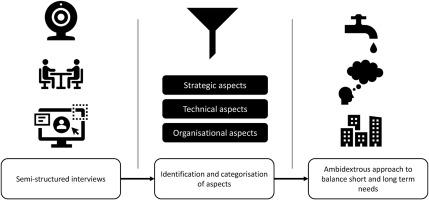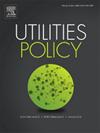数字解决方案在寻找问题?平衡水务公司的短期和长期需求
IF 4.4
3区 经济学
Q3 ENERGY & FUELS
引用次数: 0
摘要
数字化已经在更广泛的水务领域引起了人们的兴趣,数据驱动的解决方案被视为这一发展的关键。数字技术通常被描述为解决当前和未来挑战的解决方案,并已在城市水管理的所有领域确定了潜在的应用。然而,它们在水务公司的执行仍然有限。本文探讨了数据驱动解决方案的使用如何与水务公司的感知需求保持一致并解决这些需求。它基于对瑞典水务公司的23名关键信息提供者的访谈研究,这些信息提供者参与了城市水管理中数据驱动解决方案的实施和使用。我们的研究结果表明,这些解决方案还没有很好地与公用事业的技术和组织结构相一致。虽然它们可以通过承诺提高效率和绩效来解决水务公司的长期需求,但它们在满足短期需求方面的能力较弱,这些短期需求需要简单、立竿见影的解决方案。虽然实施数据驱动的解决方案应该由实际的组织需求来证明,但我们必须区分水务公司的短期和长期需求。优先考虑短期需求可能在短期内更有效,但从长远来看可能是有害的,这给水务公司造成了两面性的困境。公用事业公司应制订兼顾短期及长远需要的数码愿景或策略,以充分受惠于数码化。本文章由计算机程序翻译,如有差异,请以英文原文为准。

Digital solutions in search of a problem? Balancing short-term and long-term needs in water utilities
Digitalisation has gained interest in the broader water sector, with data-driven solutions seen as key to this development. Digital technologies are often portrayed as solutions to current and future challenges and potential applications have been identified across all areas of urban water management. However, their implementation in water utilities remains limited. This paper examines how the use of data-driven solutions aligns with and addresses the perceived needs of water utilities. It is based on an interview study with 23 key informants from Swedish water utilities involved in implementing and using data-driven solutions in urban water management. Our findings suggest that these solutions are not yet well-aligned with the technical and organisational structures of utilities. While they can address the long-term needs of water utilities with promises of improved efficiency and performance, they are less equipped to meet short-term needs which call for simple, immediate-impact solutions. Although implementing data-driven solutions should be justified by actual organisational needs, we must distinguish between the short-term and long-term needs of water utilities. Prioritising short-term needs may be more efficient in the short run but can be detrimental in the long run, which creates an ambidexterity dilemma for water utilities. Utilities should formulate digital vision or strategies that consider both the short-term and long-term needs of utilities to benefit fully from digitalisation.
求助全文
通过发布文献求助,成功后即可免费获取论文全文。
去求助
来源期刊

Utilities Policy
ENERGY & FUELS-ENVIRONMENTAL SCIENCES
CiteScore
6.80
自引率
10.00%
发文量
94
审稿时长
66 days
期刊介绍:
Utilities Policy is deliberately international, interdisciplinary, and intersectoral. Articles address utility trends and issues in both developed and developing economies. Authors and reviewers come from various disciplines, including economics, political science, sociology, law, finance, accounting, management, and engineering. Areas of focus include the utility and network industries providing essential electricity, natural gas, water and wastewater, solid waste, communications, broadband, postal, and public transportation services.
Utilities Policy invites submissions that apply various quantitative and qualitative methods. Contributions are welcome from both established and emerging scholars as well as accomplished practitioners. Interdisciplinary, comparative, and applied works are encouraged. Submissions to the journal should have a clear focus on governance, performance, and/or analysis of public utilities with an aim toward informing the policymaking process and providing recommendations as appropriate. Relevant topics and issues include but are not limited to industry structures and ownership, market design and dynamics, economic development, resource planning, system modeling, accounting and finance, infrastructure investment, supply and demand efficiency, strategic management and productivity, network operations and integration, supply chains, adaptation and flexibility, service-quality standards, benchmarking and metrics, benefit-cost analysis, behavior and incentives, pricing and demand response, economic and environmental regulation, regulatory performance and impact, restructuring and deregulation, and policy institutions.
 求助内容:
求助内容: 应助结果提醒方式:
应助结果提醒方式:


